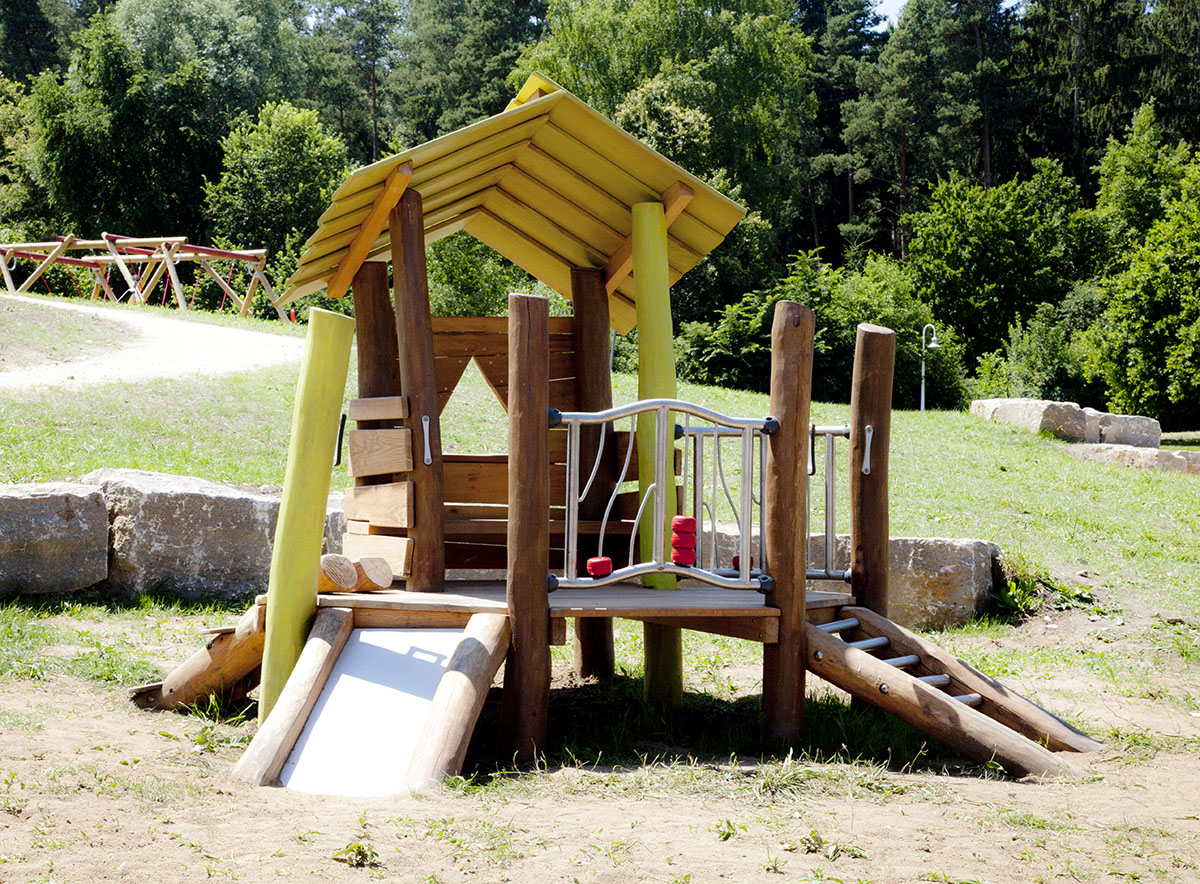Thanks to its resistance, the Robinia wood is excellently suited for the construction of playground structures and playground equipment for outdoor use. In this blog article, you will learn everything you need to know about Robinia and its material properties.
Table of contents
- Robinia wood – a profile
- Properties of Robinia wood
- How the Robinia came to Europe & spread
- Technical data of the common Robinia
- Use of Robinia wood for eibe playground equipment
- Further, important information about eibe playground equipment made of the Robinia wood
Robinia wood – a profile
The Robinia is a deciduous tree that comes from North America. Today it is widespread throughout Europe. The official name of the tree species is “common Robinia”. Colloquially, however, the tree is also called Silver Rain, False Acacia and False Acacia (due to the similar shape of the pinnate leaves and thorns) or Robinia for short. You can read everything you need to know about Robinia wood in our fact sheet:
- Botanical name: Robinia pseudoacacia
- Family: Legumes (Fabaceae)
- Subfamily: Butterfly plants (Faboideae)
- Distribution: North America (origin), Europe, North Africa, West & East Asia
- Leaves: Alternate and imparipinnate leaves consisting of several small, ovate individual leaves (greening late in spring)
- Inflorescences and flowers: strong-smelling, white flowers, growing in pendulous inflorescences as racemes
- Flowering time: May to June
- Fruits: flat, brown pods (seeds inside)
- Growth: branches twisted on a short stem that tends to form a double crown
- Roots: root fruiting ability (plants continue to grow after uprooting & even stronger than before)
- Maximum tree height: 12 to 20m in free-standing, 20 to 30m in closed stands
- Maximum age: 100 to 200 years
- Bark: rough, thick bark, deeply grooved and often longitudinally fissured, grey to dark brown
- Preferred habitat: light, dry, loose soil
- Frost hardiness: Largely frost hardy
- Characteristics: The Robinia is considered highly poisonous, especially the bark and fruit of
- the tree, but also the leaves. The flowers, however, are not poisonous.
By the way: The common locust is Germany’s Tree of the Year 2020. You can read about which trees have received the “Tree of the Year” award in previous years here.
Properties of Robinia wood
Robinia wood is so well suited for playground equipment because it is characterised by a number of outstanding properties:
- Robinia is very resistant.
- Robinia wood can be used outdoors without impregnation.
- Robinia withstands weathering without developing mould.
- Robinia wood is odourless and also has a high natural resistance to fungi and insects.
Resistance class of Robinia pseudoacacia
DiThe DIN-EN 350-2 standard divides wood species into classes according to their resistance. The common Robinia is the only wood species cultivated in Europe in the resistance class 1-2, which means that the tree is classified as durable to very durable in the durability class according to DIN EN 350-2 for woods in contact with the soil. Robinia wood can therefore be used anywhere outdoors without impregnation. This makes it a sensible alternative to tropical wood. However, the high resistance to plant and animal pests is only achieved by the heartwood. This makes up approx. 70 – 80% of the trunk cross-section.

Further special properties
- Extreme hardness: Robinia wood convinces with its hardness. This is particularly noticeable in the high wear resistance but also the resistance to abrasion. The values for compression strength, buckling strength, tensile strength, bending strength and elasticity of Robinia are higher than those of all other native wood species.
- Elasticity: Robinia wood is also highly resistant to dynamic stress. These two properties in combination make the wood perfect for the construction of playground equipment for children.
- Fast-growing: Some trees grow quickly but do not have particularly dense and strong wood. Or they have wood that is heavy and dense but grow rather slowly. The Robinia combines both – it grows very quickly and has an enormously high density.
How the Robinia came to Europe & spread
The Robinia has been able to spread widely since the middle of the 19th century, mainly for ecological reasons. Only since the Second World War has the Robinia also been considered important as a forest tree and for timber production. Before that, the deciduous tree was mainly used to pave road embankments, for example, because of its distinctive root system.
The Robinia is cultivated and used especially in south-eastern European countries. In Germany, three-quarters of the identified Robinia cultivation areas are in Brandenburg and Saxony-Anhalt. The current popularity of the Robinia in Europe is due to its values and properties, which, by the way, no other native tree can match.
Technical data of the common Robinia
- Abbreviation DIN: ROB (international: ROPS, AM)
- Approx. 930 kg/m³ (undried) & approx. 660 to 790 kg/m³ (kiln-dried)
- Bulk density: 0.73 g/ m³
- Compressive strength: 58-72 N/mm²
- Flexural strength: 118-145 N/mm²
- Modulus of elasticity: 11 600-17 900 N/mm²
- Natural durability (according to DIN-EN 350-2): Class 1 to 2
Use of Robinia wood for eibe play equipment
For some of our playground equipment, we use sapwood-free, naturally durable Robinia heartwood with an organically grown appearance. This is very robust and therefore ensures an extraordinarily long service life for the products. Even though the wood properties are otherwise more likely to be found in tropical woods, the Robinia is a tree that grows in Europe. By the way: Our used wood is generally 100% FSC® COC-certified, core-separated, dry, seasoned, and from European stocks. The type of wood we use, Robinia, is processed in its raw state or refined with caring oils based on naturally grown raw materials (tested according to DIN EN 71-3).
Further important information about eibe play equipment made of Robinia wood
- Hazard class: 4 – direct contact with the ground
- Durability class: untreated 1 to 2
- Natural protection against insects/bugs (except termites) and fungi
- Protected against solar radiation by oil (coloured or transparent)
For further information: Larch wood is also suitable as a material for playground equipment. We have summarised everything important about larch for you!

